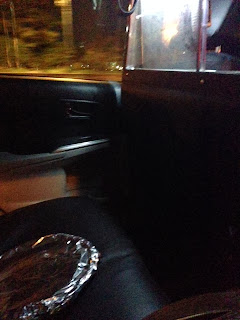“My eyes are getting hot in this blindfold. Can you fan me?” I heard one of my fellow dinner guests ask her date. In the distance, a woman was insisting to the maître d’, “I eat fish but not fish in things. Absolutely no cream sauce. Oh, and I’m gluten-free.”
We were standing outside Camaje, a West Village bistro, waiting to place our hands on a stranger’s shoulders and be escorted over the threshold for a four-course “dinner in the dark.” Just moments before we had been handed our deluxe blindfolds (which featured inlets to accommodate eyelashes). As my companion and I fastened the Velcro around each other’s heads, we realized how much trust we were putting in our hosts, and in our fellow New Yorkers.
One might expect that, at a blindfolded meal, the four other senses would be heightened. This, however, was not our experience. The menu was revealed only at the end, and we were shocked to realize how often we had misidentified the food, and how much taste depends on sight. What tasted like tomato soup turned out to be leek and cauliflower; what smelled like white wine turned out to be red. Perhaps because our senses of taste and smell seemed dulled, both my companion and I felt desperate to touch things. As soon as I was led to my seat I found myself groping around, and was relieved to find a wall to my left and my companion’s knees under the table.
We quickly abandoned our flatware, finding it more satisfying to eat with our fingers. Somehow raising an unknown food to one’s lips on the end of a fork required too big a leap of faith: through touch we could gain some sense of the food’s texture, temperature, size, pliability. At one point I jabbed my fork toward my plate and was astonished by its weight when I lifted it up. I bit cautiously: a whole sweet potato.
As we were encouraged to do, we tried feeding each other everything from wine to salad, aiming our utensils blindly across the table. We also fed each other with our hands, fumbling first to find each other’s mouths, but somehow this gesture felt too forceful. At one point a server came around and gave me a gentle and thrilling shoulder rub, though it would have been unwelcome in another context. Somehow, much like at a doctor’s office, we stopped caring what the wait-staff thought of us as we entered our own dark worlds more completely over the three-hour meal.
At restaurants it’s easy to be distracted by the conversation of the diners around you, but because we couldn’t see anyone we found it was impossible to eavesdrop. By contrast, our own conversation seemed especially focused and intimate, though if there was a pause we both felt unmoored. Between courses, musicians performed on unidentifiable instruments, and we could hear pots and pans clattering in the kitchen behind us. We experimented with blind lip-reading (a test of intuition), then attempted to read each other’s lips pressed into our hands, Helen Keller–style. Each sound, taste, smell, and texture—though muted—used up a moment in its entirety. We were more present for this meal than we had been for any meal in a long time.
The staff also encouraged us to take photographs, so with some assistance navigating my phone, I took blind photos of my surroundings. Emerging back onto the sidewalk at the end of the evening, I was astonished to realize how small the room had been, and how bright. I also noticed that the room was hung with mirrors, witnesses to twenty or so New Yorkers unexpectedly blessed with vulnerability and presence.
























































